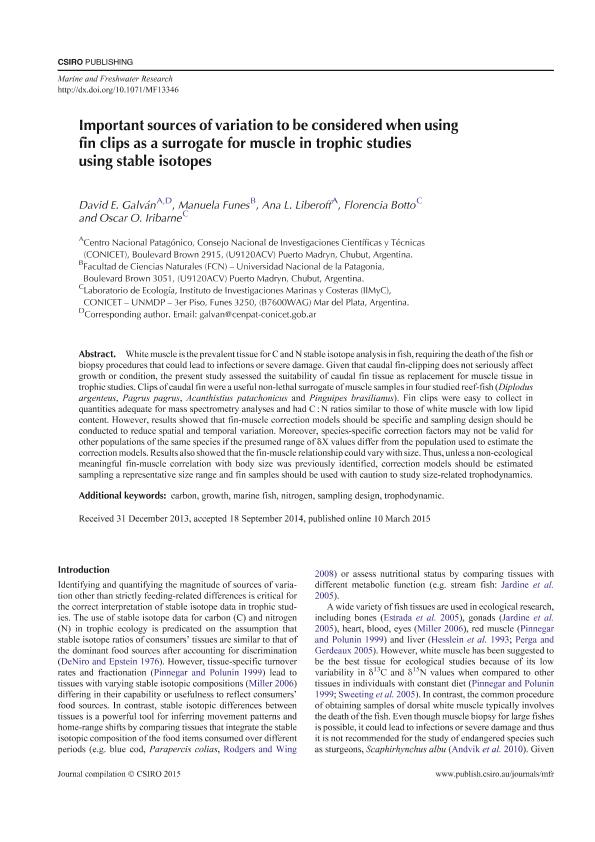Artículo
Important sources of variation to be considered when using fin clips as a surrogate for muscle in trophic studies using stable isotopes
Galvan, David Edgardo ; Funes, Manuela
; Funes, Manuela ; Liberoff, Ana Laura
; Liberoff, Ana Laura ; Botto, Florencia
; Botto, Florencia ; Iribarne, Oscar Osvaldo
; Iribarne, Oscar Osvaldo
 ; Funes, Manuela
; Funes, Manuela ; Liberoff, Ana Laura
; Liberoff, Ana Laura ; Botto, Florencia
; Botto, Florencia ; Iribarne, Oscar Osvaldo
; Iribarne, Oscar Osvaldo
Fecha de publicación:
10/03/2015
Editorial:
Csiro Publishing
Revista:
Marine and Freshwater Research
ISSN:
1323-1650
Idioma:
Inglés
Tipo de recurso:
Artículo publicado
Clasificación temática:
Resumen
White muscle is the prevalent tissue for C and N stable isotope analysis in fish, requiring the death of the fish or biopsy procedures that could lead to infections or severe damage. Given that caudal fin-clipping does not seriously affect growth or condition, the present study assessed the suitability of caudal fin tissue as replacement for muscle tissue in trophic studies. Clips of caudal fin were a useful non-lethal surrogate of muscle samples in four studied reef-fish (Diplodus argenteus, Pagrus pagrus, Acanthistius patachonicus and Pinguipes brasilianus). Fin clips were easy to collect in quantities adequate for mass spectrometry analyses and had C : N ratios similar to those of white muscle with low lipid content. However, results showed that fin-muscle correction models should be specific and sampling design should be conducted to reduce spatial and temporal variation. Moreover, species-specific correction factors may not be valid for other populations of the same species if the presumed range of δX values differ from the population used to estimate the correction models. Results also showed that the fin-muscle relationship could vary with size. Thus, unless a non-ecological meaningful fin-muscle correlation with body size was previously identified, correction models should be estimated sampling a representative size range and fin samples should be used with caution to study size-related trophodynamics.
Palabras clave:
Carbon
,
Growth
,
Marine Fish
,
Nitrogen
,
Sampling Design
,
Trophodynamic.
Archivos asociados
Licencia
Identificadores
Colecciones
Articulos(CCT-CENPAT)
Articulos de CTRO.CIENTIFICO TECNOL.CONICET - CENPAT
Articulos de CTRO.CIENTIFICO TECNOL.CONICET - CENPAT
Citación
Galvan, David Edgardo; Funes, Manuela; Liberoff, Ana Laura; Botto, Florencia; Iribarne, Oscar Osvaldo; Important sources of variation to be considered when using fin clips as a surrogate for muscle in trophic studies using stable isotopes; Csiro Publishing; Marine and Freshwater Research; 66; 8; 10-3-2015; 730-738
Compartir
Altmétricas



